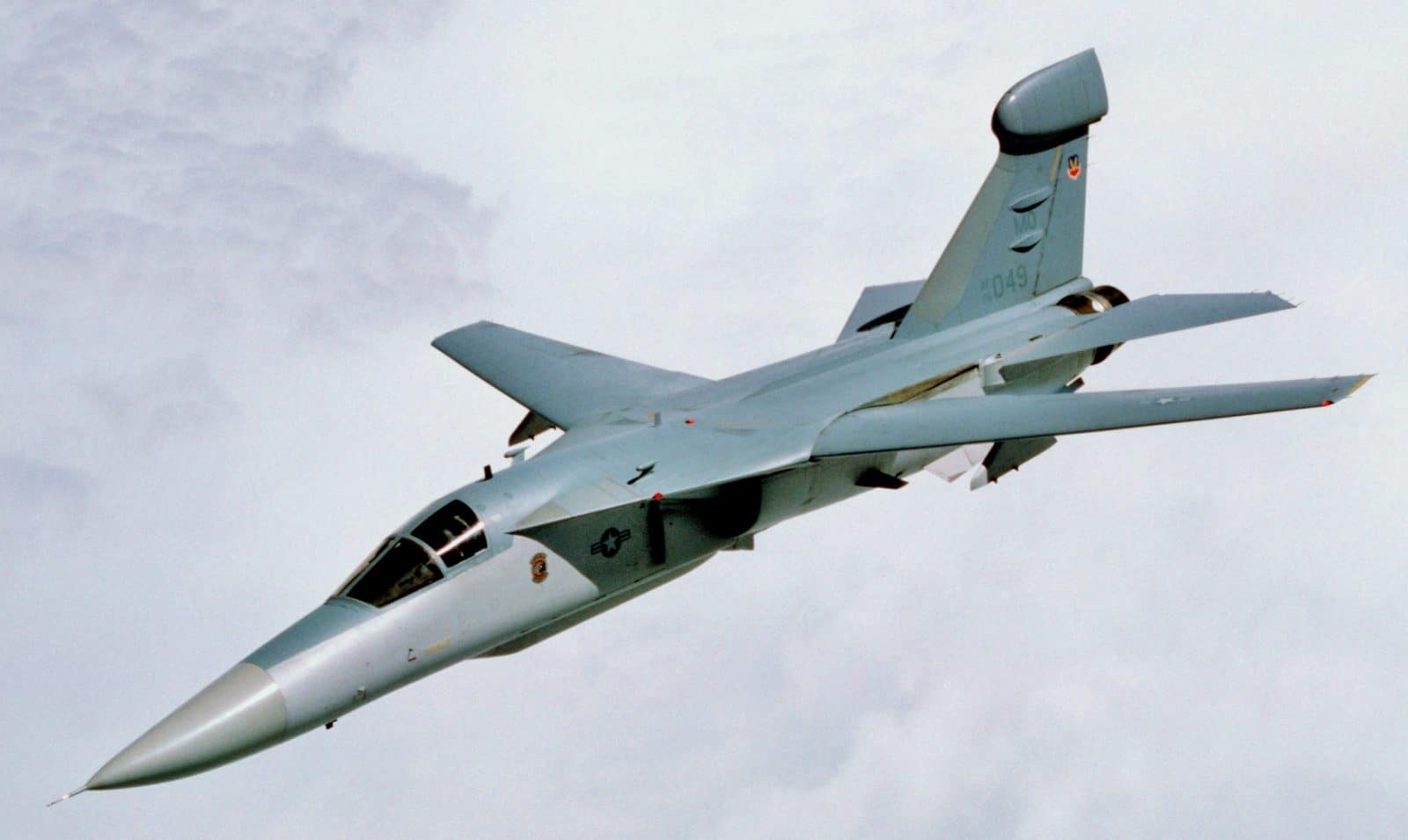The Delta Was Too Much Too Soon
Next up was the F-111D for the Air Force. This variant was essentially an F-111A equipped with Mark II avionics, uprated TF30 engines fed by improved air intakes, and some of the first “glass” display screen cockpits in the Air Force.
Equipping only the 27th Tactical Fighter Wing (TFW) at Cannon AFB in New Mexico, the F-111Ds had some initial avionics reliability issues. Microprocessors were brand new back then, and it took a while before the Air Force sort of pulled the plug on figuring out the D, retiring them somewhat prematurely in 1991-1992.

Building a Really Fast Bridge
The F-111E was an interim variant that incorporated the improved Triple Plow II boundary layer control engine air intakes but retained the same TF30 power plants as the F-111A. There was an improved stores management system and a few other incremental upgrades.
Some of the E variants ended up with uprated engines and some avionics upgrades. However, the F-111E was a bridge to the next variant of the F-111.

The Ultimate Aardvark
The F-111F was the last variant of the F-111 built for Tactical Air Command (TAC). The Mark IIB avionics suite was more capable with fewer teething problems than the Mark II suite. The F had the improved engine air intakes feeding TF30-P-100 engines, providing a 35% increase in thrust.
The F-111F also carried a Pave Tack forward-looking infrared (FLIR) and laser target designator system in its weapons bay. The system rotated into a ventral position when in use. Later upgrades included even more powerful TF30 engines and multi-function cockpit displays.

Frankenstein Varks in Service With SAC
The FB-111A was the first Strategic Air Command (SAC) version of the F-111A. Intended to replace both the Convair B-58 Hustler and the early Boeing B-52 Stratofortress variants, the FB-111A was equipped with yet another avionics suite, this one called the SAC Mark IIB. Also rolled into the FB-111A were strengthened landing gear allowing a heavier max takeoff weight, the popular longer B model wings, a redesigned rear fuselage, and other incremental improvements.
A third pylon was added to each wing. FB-111As were retired when the Rockwell B-1B Lancer went into service. Many of the FB-111As were converted to F-111Gs for TAC to use primarily as trainers. Some of them were sold to the RAAF.

The Royal Air Force Almost Went F-111
The Royal Air Force toyed with the notion of employing the F-111. Their version, dubbed the F-111K, would have been a replacement for the canceled BAC TSR-2 attack aircraft. Ordered in 1967, the F-111K was to be an F-111A with longer F-111B wings, upgraded avionics, and British mission-specific systems, the FB-111A landing gear, a refueling probe, and the ability to carry a reconnaissance “pallet” in the weapons bay.
The RAF canceled their order in January 1968 before any F-111Ks were completed. Parts for the F-111K program were diverted to the construction of the SAC FB-111As.

The Spark Vark
The final version of the F-111 was the EF-111A Raven. This tactical electronic warfare version, intended to replace the Douglas EB-66 Destroyer, was equipped with a mission avionics suite developed largely from the avionics found in the Navy’s Grumman EA-6B Prowler.
Grumman again partnered with GD to build the EF-111A, which, in general terms, was a rebuilt F-111A equipped with advanced avionics and a dedicated electronic warfare operator position in the cockpit. The EF-111A Spark Varks were the last F-111 variants to be retired by the Air Force on 2 May 1998 at Cannon AFB.

Combat TV Stars
F-111s were used in combat during Operation El Dorado Canyon and, of course, during the Gulf War. Their record for going in fast and low and planting their bombs dead on target is the stuff of legends. Often, when the public was treated to footage of bomb damage, that video was captured by the Pave Tack pods on F-111Fs.
The Air Force officially retired the last operational F-111Fs on 27 July 1996. It was not until that day that the Air Force officially recognized the nickname of Aardvark for the F-111. They were replaced by McDonnell Douglas (Boeing) F-15E Strike Eagles.


The TF-30s were the first time afterburners were fitted to a turbofan engine. The F-111s carried as much weight in internal fuel as an F-4 weighed at landing, approximately 40,000 lbs. The vertical stabilizer had a 71 gallon expansion tank built in it to help prevent venting fuel overboard. The ejection sequence used a flexible linear shaped charge to cut the skin between the ejection module and the fuselage before it could be launched away from the aircraft with the rocket. The attack RADAR and the TFR antennas were mounted on a gyro stabilized pallet that allowed the TFR antennas to always scan vertically and the attack RADAR antenna to always scan horizontally regardless of the airframe orientation in relation to the earth.